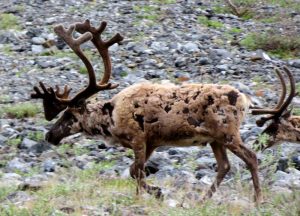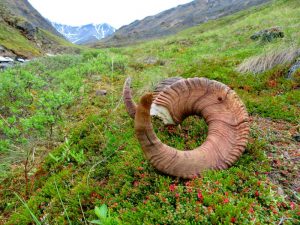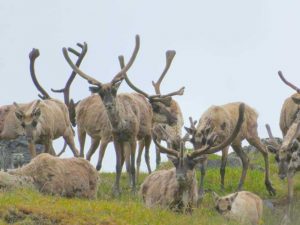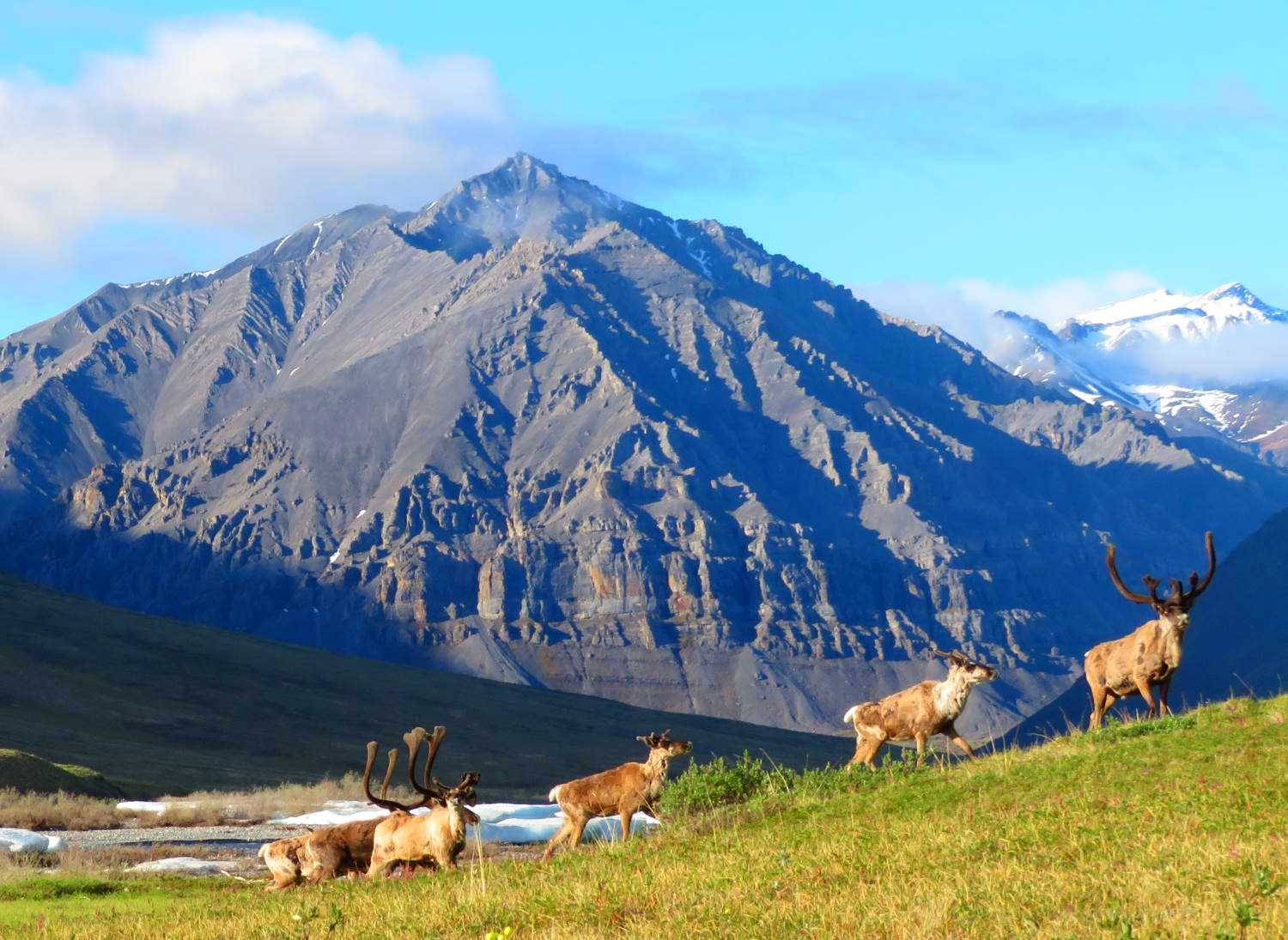July 5 I’m suddenly awake. What’s that? There’s an animal outside my tent! A big animal! I grab my bear spray and quickly unzip the mosquito net and my shelter door and look out. A band of caribou is heading for my tent. They veer off a little when they see me. They continue on their way, eyeing me curiously and cautiously as they trot across the tundra.
My heart soars. They are beautiful animals with several magnificent bulls. The rich light of the morning sun washes across the tundra and the rugged snow-capped mountains, all under a blue sky with a few drifting clouds. What a glorious morning in this remote wilderness, a wilderness that is all my own.
I pack up my camp and hike up the valley following the river. After a few miles a rugged mountain stands between two branches of the river. I stop to check my location on my GPS map. I need to follow the left fork up ahead, a major side drainage. As I near the fork a large band of caribou comes around the corner. I sit down among some low willows and take out my camera. I watch for a while, waiting for the herd to pass, but each time I think I’ve seen the last of them more appear. Finally I stand up and walk down to the river and easily ford the many braids.

Some of the caribou don’t notice me at first and when they do they run a short distance in random directions, but eventually they all travel downstream, towards the coastal plain. I reach the confluence and leave the main fork of the Aichilik River behind. This valley is much narrower so when I see bands of caribou approaching I sit quietly in the willows and let them pass to prevent undue panic. It’s really fun to have so many large animals pass so closely. Many times individuals spot me and it’s almost as if they are pretending they don’t see me, as if they are thinking that if I am going to rush out and kill one of them, it probably won’t be them, that it will be best if they just stay with the herd and hope for the best. At this close range I can easily see how they are shedding patches of winter hair. I am amused that, for all the many miles they are covering, many of the calves playfully run in circles.

For hours I hike up the narrow valley with bands of caribou trickling past. My next turnoff is at a minor confluence. At times this tributary narrows to a boulder-filled chute. Sometimes I wade up the creek among the rocks, between the steep walls of the ravine, surrounded by the sound and smell of cold rushing water. When the water is too deep I climb the bluff and walk the mountainside. Numerous side drainages make the going slow.

Lying on the green tundra is a magnificent set of Dall sheep horns. They are from a full-curl ram, nine years old judging from the growth rings on his massive horns. Oh, the things he must have seen in these remote, lonely mountains! Those weeks-long winter nights, forty below zero on windy mountainsides. Did he appreciate the endless summer days?
On a slope ahead antlers wave as a band of caribou bulls trot over the skyline. There are far more bulls today. The first days of my hike it was mostly cows and calves. This band doesn’t see me at all. I sit quietly as they trot past.

The walking has gotten easier again. No more wading up the creek. I consider camping at a nice flat area but when I look at the map I decide to push on for the divide. Dramatic mountains rise all around me. As the creek dwindles to a brook and then to a trickle I fill up two water bottles then slowly continue my plod up the mountain. What appears to be the last caribou, a lone bull, trots down the drainage. I sit down and he passes a stone’s throw away, intent on catching up with the herd.
I’ve climbed over two thousand feet today. The clouds have come down and it’s misting rain. I’m wearing my rain gear and waterproof mittens. The ground is spongy on the divide. I’m tired but this isn’t a good place to camp. I leave the Aichilik drainage behind. I will likely never see that beautiful place again. I begin descending a rocky hillside into the headwaters of the Kongakut River.
After a mile or so I make camp on a flat shelf on the mountainside. I’m tired. After setting up my shelter I pause to admire the scenery. A rocky creek-bed curves up the green valley into the glaciered Romanzof Mountains, a sub-range of the Brooks.
It feels like I’m the only person in the world.



Well done Buck
Thank you, Troop.